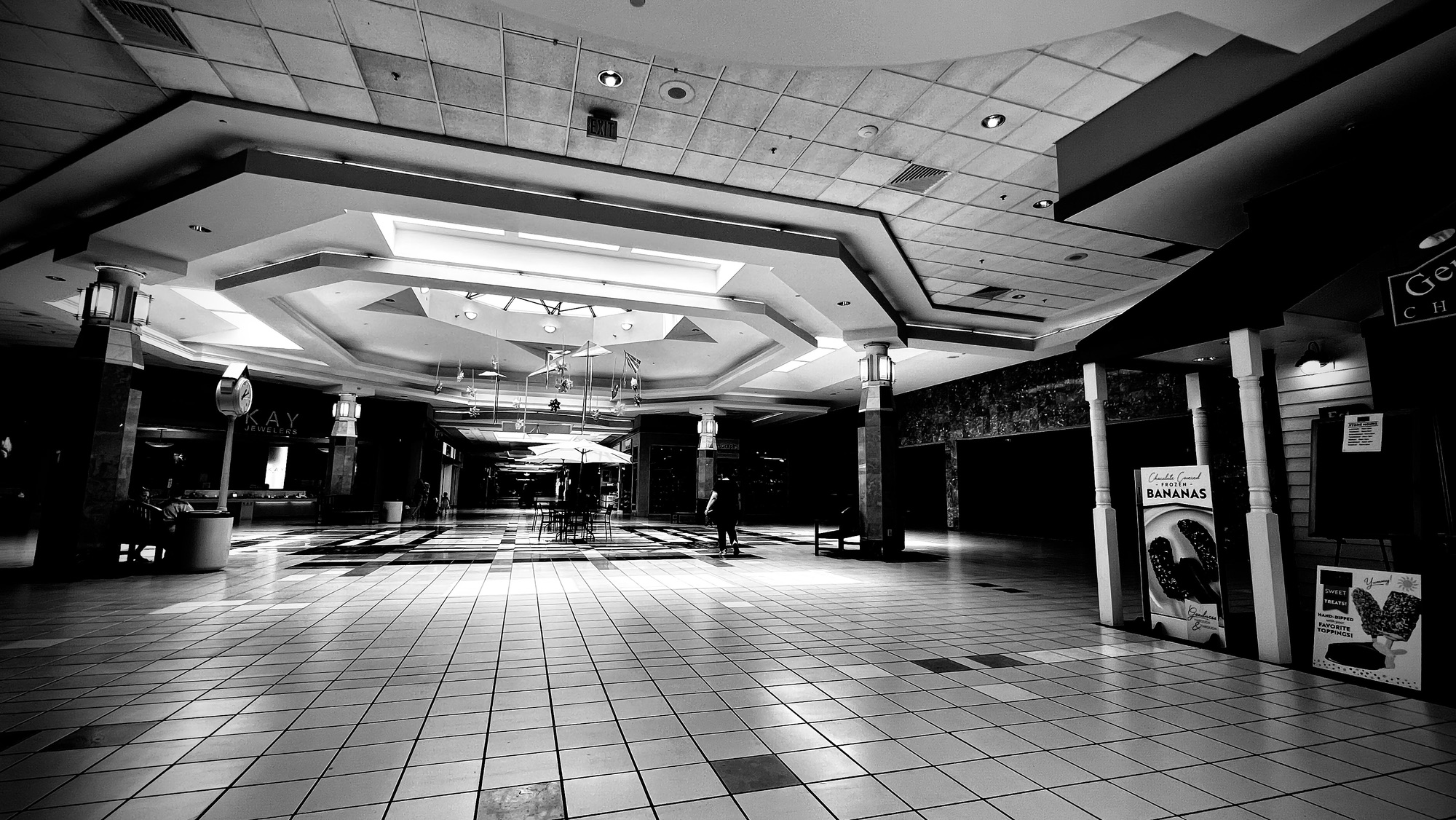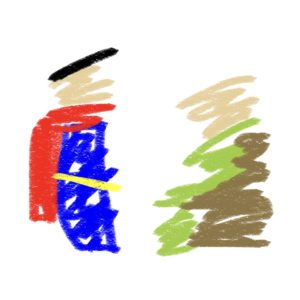Fred Skeller felt like being sad, and he could think of no better place to be sad in than the mall. So, he went.
More specifically, he stood up from the 1970s vintage floral print love seat in the living room of his parents’ split-level suburban home, exited the house, and slid into the driver’s seat of his nearly-paid-off 2007 Honda Civic LX, Starlight Silver paint gleaming in the late afternoon sun. After some searching, he found a radio station that was somehow both still on the air and was playing the iconoclastic, trendsetting music of his youth (though they kept calling it “Classic Rock”). He opened the sun roof, spun the plastic volume knob until the sound level was just shy of uncomfortable, and drove four-and-half miles over marginally-paved country back roads and a short segment of interstate highway to the parking lot of the sprawling shopping center where he had spent many formative hours of his childhood.
It was mostly empty. The years had been unkind to malls.
Despite the emptiness, he wasn’t really sad yet. It wasn’t until he actually entered the place through the double set of heavy, creaking glass doors that he felt the first pangs of genuine sorrow.
Fred stood for a long while in the middle of the space between the candy shop and the travel agent, facing the big water fountain and the fancy department store. He closed his eyes and could almost hear the roar of the water, almost smell the stale smoke of cigarettes dying in the ashtray atop a garbage can. He knew that neither the sound nor the smell were truly present; the candy bins and the travel agents and the water and all the departments from menswear to bridal were long gone. This mall was still functioning only in the sense that nobody had bothered to chase out the last few tenants and shut off the lights.
And then, he allowed himself to slip gently down from benign nostalgia to true sadness, a mourning for simple things that were lost, and would not be again. His shoulders rose, then slumped. He exhaled a weighty sigh. His face went slack. A hint of a tear welled in the corner of a still-closed eye and threatened to migrate to his cheek.
It felt glorious.
There was something profound and comforting about grief; one of his generational idols had once expressed in song a longing for the familiar embrace of sorrow. He often found that a little positional anguish could bring back the sensations of his teenage years in a way no yearbook photos ever could. You could look at yourself being awkward all day long, but nothing was quite like going to the place where the awkwardness had happened to really feel the regret.
Fred walked.
This particular mall had been modernized just before the turn of the millennium, which meant that it looked like a relic of the 90s instead of the 70s. Everything originally wood-toned was now green, gold, and marble. The floor tile was slick and polished instead of earthy, benches looked as if they were stolen from a municipal park, and the trash cans were sadly lacking ashtrays.
But most upsetting to him personally was that the live trees had been moved to large ceramic planters. He vividly remembered the cast metal grates that covered the shallow, bark-mulch-filled tree plots; the radial slits encircled a central aperture where the tree grew. He wondered if they had been designed to look exactly like the set of the carbon-freezing chamber in The Empire Strikes Back, or if the set designer had spent a lot of time in malls.
At the time, of course, the update had been a breath of fresh air, and it had brought with it such wonders as chain restaurants, The Gap, and even Cinnabon—formerly reserved for more sophisticated locales like Albany or mid-state New Jersey. But now the original was safely in the nostalgia zone of his life’s timeline, and he missed it. He walked by a brass outlet cover on a wall between two defunct stores that had been a jeweler and something he couldn’t remember—children’s clothing?—and noticed it was still the original tarnished, dingy bronze he remembered. Maybe they missed that one, he thought. Or maybe not everything gets a design update. Maybe a commercial electrical outlet always just looks like that. He felt some comfort at the idea.
He passed a cell phone store with a single bored-looking employee. An older couple, doing laps, walked by. “Hiya,” the woman said.
“Hiya,” Fred replied, smiling politely.
“Gotta keep moving or you’ll forget how,” the man said.
“That’s for sure!” he replied, giving a brief chuckle at the completely banal and not at all genuinely humorous exchange, again, out of sheer politeness.
“See ya ‘round the way!” the woman said.
“Sure will!” Sometimes he missed the casual but not overbearing friendliness of the Mid-Atlantic. Not as cold as New England, not as “bless your heart” phony as the Deep South. A nice happy medium.
Fred walked. A corner spot was vacant. He remembered that it had once been a Spencer Gifts, with its assortment of lava lamps and posters and stoner/frat-house couture. It was really only part of his regular window-shopping circuit because it had a wide variety of stickers (which had been a hot commodity in his Trapper Keeper years) as well as some toys. It brought a hint of a smile to his face before he remembered his mission, and he pivoted expertly to wistfulness.
They called it “window-shopping” (he remembered with an appropriate air of sepia-toned melancholy), but it was more a sort of browsing ritual: you didn’t go to the mall just because you needed to buy things. That wasn’t the point. The point was to look at things that interested you, to fantasize, perhaps, but also to maintain an awareness of the latest consumer goods, and to get up close with things previously only seen on TV. And so, everybody had a sort of mental list of the stores they’d habitually visit: for him, it focused on places with toys, but also included books, music, and other odds and ends. He’d hit every one of the stores on his list, like clockwork, only breaking routine for a special occasion—like actually needing to make a purchase.
Fred walked some more. The next empty space had been a diner-style restaurant; it still had its own separate small entrance door, like the drug store that had been halfway down the other end of the mall’s main thoroughfare. He remembered eating ice cream there, just as he remembered looking at cheap knockoff Transfomers in the toy section of the drug store. The next space had been a shoe store, the next a greeting card store, the next was something else he didn’t remember. And then, the toy store. The dedicated, focused, fit-for-purpose toy store.
He felt a real sense of loss: how long had it been since he had seen toys for sale anywhere but a few aisles in a Target? Sure, there were still specialty hobby stores, and he had been to high-end “educational” stores that sold wooden blocks and science experiment kits and glow-in-the-dark princess rocket ship dinosaur tents with real working astronomically-accurate star projectors, but it wasn’t the same. Where were the realistic toy guns? The walls of cardboard-backed action figures? The Nintendo cartridges hanging behind the register, beckoning to be taken home for just a few months’ allowance?
Now, it was just another clothing store—he paused at the illuminated sign over the entrance. Not sure I’d wear an outfit from a place with “Barn” in the name, he thought. He looked closely at the edges of the window, the trim where the wall met the floor, even the ceiling, searching for an artifact of the old store, a fleck of bright blue carpeting, a hint of history. He found nothing.
Dejected but unsurprised, he turned. There was a wide-open space here, at one end of the long axis of the original mall’s layout. Once, it had contained a sort of low stage: three or four broad tiers of stairs leading up to a wishing pool with three short, roaring fountains, and then a flat area where performers had occasionally put on their acts of magic or music or dance. He could see the dark brown tile in his mind, and the tall built-in planters at stage left and stage right thick with some kind of broad-leafed plants, but the only thing that remained was the modernist light fixture hanging from the skylight above.
The entrance to one of the anchor stores was still here, mostly unchanged from his memory. In his youth, a short spur had led past a couple of stores—one that sold pocketknives, and had been on his regular circuit—and terminated in another set of glass exit doors. The mall’s expansion had extended the spur into a corridor leading to another wing of stores, but he wasn’t interested. First, it wasn’t part of the “original” mall. Second, an unassuming segment of blank storefront had his full attention.
The Peanut Shack. Oh, the Peanut Shack.
There was no name more succinctly descriptive. To be fair, they sold other things besides peanuts, like cashews and sunflower seeds, and he remembered particularly a snack mix containing sesame sticks and what might’ve been shelled pumpkin seeds. They were all in stainless steel bins under warming lights with the price per pound marked on the front in moveable plastic numbers; often he’d dreamed of being able to buy a whole pound of something. But they had been good about him asking for “a dollar’s worth” instead, carefully weighing out a precise quantity of salty goodness to equal exactly a buck. He couldn’t remember if there had been sales tax on it. He supposed he must have had an extra six cents ready, just in case.
And then, there were Slush Puppies. If peanuts and snack mix were childhood caviar, then the icy, sticky-sweet half-beverage and half-snow cone was the champagne. There were other slush-type beverages available, but the magic of the Slush Puppie came from the selection of flavored syrups that went into the cup before being mixed with a generous pour of ice granules. There were your standard flavors, like cherry and grape—these tasted less like the fruits and more like the concepts of the colors red and purple—but also more exotic ones, like bubble gum and his personal favorite: Bahama Mama. It tasted how he imagined a tropical beach would taste if it had less sand and more fructose.
Most people couldn’t actually finish a Slush Puppie, because the syrup had a tendency to filter through the ice and pool in the bottom. If you drank it with the included spoon-straw, there was a near certainty that you’d drink all the syrup long before you finished the last of the slush. The remainder was ice with the memory of flavor; it was like chewing on snow after spitting out a piece of stale gum.
Fred always finished his. He couldn’t get enough.
There had been a limiting factor, though. Not money, exactly; though he was careful with his allowance, he had plenty of memories of slush paired with snack mix or cashew pieces (cheaper than whole nuts, or even halves). No, it was his parents.
He didn’t remember whether their exact reasoning was based on dental health, a desire to teach the virtues of frugality, or simply legitimate concern over a child drinking pure corn syrup mixed liberally with FD&C Blue #17. Whatever it was, he was restricted to one size cup: small.
He had tried to argue for a medium. “I won’t get anything else,” he had pleaded. “I’ll do some extra chores. I’ll run home from the mall. James and Matt get mediums! One time Matt got a large!”
Fred was neither James nor Matt, and his argument was unsuccessful. So, a small it was, and he savored it to the last granule. But he could dream, and those dreams often took the shape of a big, waxy cup, plastic dome overflowing with Bahama Mama Slush Puppie.
Like that dream, the actual Peanut Shack had faded into memory. He was left standing on faux-marble tile, staring at a wall. He looked around. There was nobody close by who might wonder what he was doing. He once again closed his eyes, remembering.
And then, something peculiar happened. He found that, as before, he could almost smell the warm peanuts, the chlorine tang of the water fountains, a whiff of cigarette smoke. The sensations grew bolder in his mind until he almost believed that he was really there, and then the smells were joined by the sounds of crashing water, the rhythm of sneakers on tile and the swish of nylon windbreakers and Members Only jackets, the soft murmur of conversation, the soothing tones of Muzak through overhead speakers. It felt real. All too real.
He opened his eyes. He saw wood grain and orange Formica countertops. He saw bins of warm almonds and macadamias and three varieties of trail mix under heat lamps. He saw pump bottles of brightly-colored syrup and a cartoon dog holding a cup filled with red slush. He saw the Peanut Shack, resplendent in its glory.
He was there. Somehow, impossibly, he was there, in the shopping mall he remembered, the way he remembered.
Eyes wide, he exhaled a single word that, like the name “Peanut Shack,” perfectly encapsulated the very essence of his situation.
“Radical!”




Pingback: Slush Puppie – Part 2 - january-river.net
Pingback: Slush Puppie – Part 3 - january-river.net